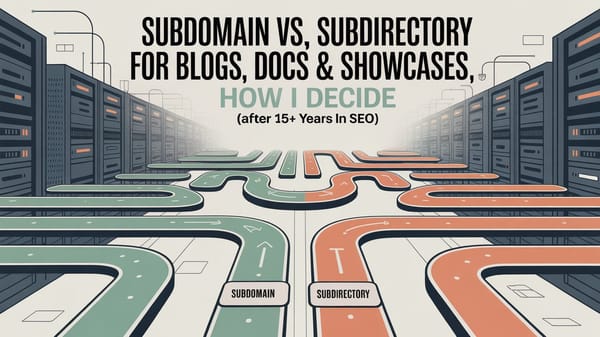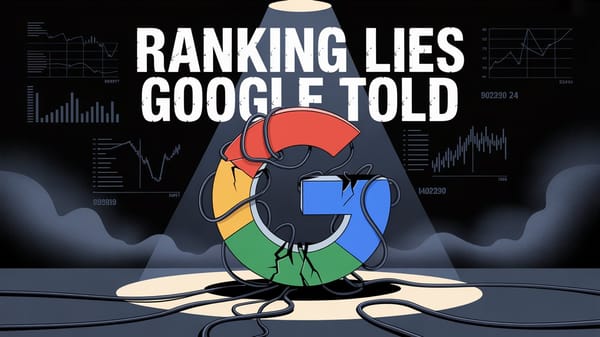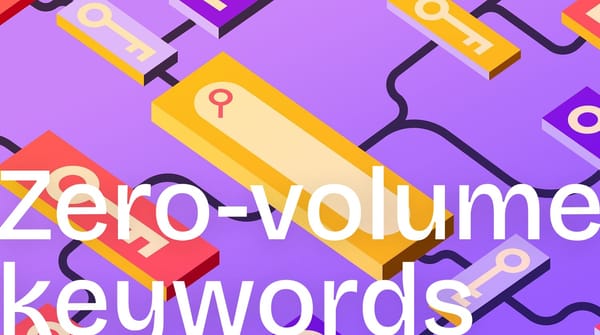Well, it seems Google has finally let the cat out of the bag!
Google's algorithm has always been a closely guarded secret, with SEO professionals constantly trying to decipher the factors that influence search rankings. However, a recent leak of Google's internal documents has shed light on some of these elusive ranking factors.
Today, I will share my analysis of Google ranking algorithms on the 54 key factors that stand out as a result of all my analyses.
How SEO Experts Can Prioritize Google Ranking Factors
As an SEO expert, navigating the myriad of ranking factors can be daunting. However, prioritizing these factors effectively can significantly enhance your site's visibility and search rankings. Here’s a step-by-step guide on how to prioritize these factors based on their impact and feasibility:
1. Understand Your Audience and Goals
- Identify Target Audience: Understand who your audience is and what they are searching for.
- Set Clear Goals: Define what you want to achieve with your SEO efforts (e.g., increased traffic, higher engagement, better conversion rates).
2. Focus on High-Impact Factors First
- Content Quality and Relevance: Ensure your content is high-quality, relevant, and provides value to users. This includes:
- IndexingInstantNewsHighlyCitedDocumentSignal: Prioritize highly cited content.
- ymylNewsScore, ymylNewsV2Score: Ensure content quality, especially in YMYL categories.
- Trust and Authority Signals: Build trust and authority by focusing on:
- newsCorpusNewsCorpusAnnotation: Enhance content authority.
- newsSource: Identify and prioritize trusted news sources.
3. Optimize User Experience (UX)
- Site Speed and Performance: Improve site speed and performance to enhance user experience.
- durationMs, instances: Measure and improve site speed.
- Mobile and Device UX: Ensure your site is optimized for mobile devices.
- mobileOwnerId, deviceUxMode: Adapt to various devices and user modes.
4. Leverage Metadata and Annotations
- Detailed Metadata: Provide detailed metadata to improve indexing and relevance.
- newspaperDate, newspaperName, newspaperUrl: Context about publication date and source.
- newsAnnotationsContentAnnotations: Detailed content annotations.
5. Enhance User Interaction and Engagement
- Engagement Metrics: Monitor and improve user engagement metrics.
- totalClicks, chromeInTotal: Track website traffic and user clicks.
- Internal Linking: Strengthen website structure with effective internal linking.
- linkedPerson, linkedDeviceId: Attributes related to internal linking.
6. Implement Geo-Targeting and Localization
- Local Content Optimization: Tailor content to specific geographic locations.
- newsNarRowContainer: Enhance local search results.
- language: Match content with users' language preferences.
7. Monitor and Avoid Duplicate Content
- Duplicate Content Detection: Regularly audit your content for duplicates.
- newsExtractionNewsPbeAnnotations: Filter duplicate content.
- newsNewsArticleChecksum: Ensure content uniqueness.
8. Build High-Quality Backlinks
- Link Quality and Diversity: Focus on earning high-quality and diverse backlinks.
- encodedNewsAnchorData: Links from high-quality news sites.
- PagerankNs: Links from trusted seed sites.
- Relevance of Links: Ensure links are relevant to the content they are placed in.
- anchorMismatchDemotion: Avoid anchor mismatch.
9. Optimize for Specialized Attributes
- Specialized News Attributes: Leverage specialized attributes for enhanced visibility.
- newsCorpusHubPageAnnotations: Identify and prioritize hub pages.
- newsNarIndexingMetadata: Provide metadata for news indexing.
10. Regularly Update and Maintain Content
- Content Freshness: Keep your content updated to reflect the latest information.
- qualityRealtimeBoostRealtimeBoostEvent: Prioritize trending news content.
- freshboxFreshboxArticleAnnotation: Prioritize fresh news articles.
- Consistent Content Dates: Maintain consistent and accurate date information.
- date, bylineDate, syntacticDate, semanticDate: Provide various date information.
11. Utilize Advanced Modules and Tools
- Goodoc Modules: Optimize document structure and metadata.
- GoodocAnchorLabel, GoodocBoundingBox: Focus on generating unique anchor labels and defining bounding boxes.
- SDR Modules: Improve embeddings and relevance scoring.
- SdrEmbedding, SdrPageAnchorsDocInfo: Enhance content processing and ranking.
12. Monitor and Adjust Based on Performance
- Regular Audits: Conduct regular audits to identify and fix issues.
- Performance Metrics: Use tools like Google Analytics and Search Console to monitor performance.
- Adjust Strategies: Be flexible and adjust your strategies based on performance data and industry trends.
54 key ranking factors from Google Content Warehouse API Leak
1. News Filtering and Identification: Optimize News Content with Precise Filtering and Identification for Better Rankings
News filtering and identification are crucial for ensuring that your news content is accurately categorized and displayed in search results. By optimizing these elements, you can improve the visibility and relevance of your news articles, making it easier for users to find the information they need.
Key Points:
- newsFilter, podcastFilter: Helps in filtering and categorizing news content, ensuring relevant news is displayed.
- state (NewsFilter): Aids in categorizing and filtering news content.
- newsSource: Identifies and prioritizes trusted news sources, influencing the credibility and ranking of news content.
- newsNarRow: Indirectly impacts ranking by giving weight to news relevance and context.
- newsNarRowContainer: Directly impacts ranking in news-related searches by providing structure and context to news content.
- ClusterId: Directly impacts search ranking by grouping similar articles.
- ClusterSize: Determines how many articles from the same cluster can be shown.
- ClusterTimeStamp: Manages the lifecycle of clusters and impacts freshness.
- indexingInstantClusterScorerArticle: Groups and prioritizes relevant articles.
2. Content Type and Topics: Enhance Visibility by Clearly Defining Content Type and Topics
Defining the type and topic of your news content helps Google understand what your articles are about, which can significantly affect their visibility in topic-specific searches. Clear categorization and topic definition can lead to better search rankings and more targeted traffic.
Key Points:
- newsTopic: Helps Google understand the specific topics covered in the news content, affecting visibility in topic-specific searches.
- newsContentType: Defines the type of news content, helping in categorizing and displaying relevant content to users.
- newsNewromanIndexingNewRomanSignal: Indirectly impacts ranking through visual presentation.
- qualityTangramInformationTypes: Categorizes content type for tailored search results.
3. Metadata and Annotations: Boost Indexing and Relevance with Detailed Metadata and Annotations
Metadata and annotations play a vital role in accurately indexing and ranking your content. By providing detailed metadata, you can help search engines understand the specifics of your articles, such as publication date and source, which can improve their relevance and visibility.
Key Points:
- newspaperDate: Provides context about the publication date.
- newspaperName: Allows users to filter or prioritize results from specific newspapers, indirectly affecting ranking.
- newspaperUrl: Provides the source URL for reference.
- newsCorpusLeafPageAnnotation: Indirectly impacts search ranking by improving content classification.
- newsAnnotationsContentAnnotations: Directly impacts ranking by providing detailed content annotations.
- newsCorpusNewsCorpusStatusAnnotation: Directly impacts ranking by evaluating the status of news content.
- newsCorpusNewsCorpusRootAnnotation: Impacts relevance for time-sensitive queries.
- freshboxFreshboxArticleAnnotation: Prioritizes fresh news articles.
4. Trust and Authority Signals: Build Trust and Authority to Improve News Content Rankings
Trust and authority signals are essential for enhancing the perceived credibility of your news content. By building a strong reputation as a reliable news source, you can positively impact your search rankings and attract more readers.
Key Points:
- newsCorpusNewsCorpusAnnotation: Directly impacts ranking in news-related searches by enhancing content authority.
- newsCorpusHubPageAnnotations: Indirectly impacts ranking by identifying authoritative content.
- narrativeNewsProviderType: Prioritizes authoritative news providers, affecting the ranking.
- newsCorpusNewsinessAnnotation: Directly impacts news-related search ranking by assessing the newsworthiness.
- newsSource: Identifies and prioritizes trusted news sources, influencing the credibility and ranking of news content. Articles from well-established and trusted sources rank higher.
- newsCorpusNewsAggregateSignal: Directly impacts ranking by aggregating signals from various news sources to assess overall authority.
- publishTimeSeconds: Influences ranking for time-sensitive news.
- newsCorpusStoryMetadata: Identifies similar articles and consolidates ranking signals.
- newsCorpusWebMetadata: Assesses reputation and authority of the news source.
- newsCorpusWebSignal: Considers overall reputation and authority.
- language: Matches content with users' language preferences.
5. User Interaction and Engagement: Increase Rankings with Engaging and Interactive News Content
User interaction and engagement metrics are critical for improving your news content's search rankings. By creating engaging content that encourages user interaction, you can boost your site's visibility and attract more readers.
Key Points:
- newsVideosNewsVideoAnnotationSignals: Directly impacts video search ranking by understanding user interactions.
- newsNewsContentSignals: Directly impacts news search ranking by assessing user engagement with news content.
- newsVideosNewsAnchorSourceInfo: Considers credibility and authority of news video sources.
- totalClicks, chromeInTotal: Tracks website traffic and user clicks, indirectly impacting search ranking by providing insights into user engagement and behavior.
- coClicks, coClickTarget: Tracks co-clicks from related searches, indirectly influencing search ranking by associating your content with other relevant searches.
- navboostScore, navmenuScore, titleScore, longClick: Internal scoring signals that might affect the appearance and ranking of sitelinks.
6. Geo-Targeting and Localization: Improve Local Search Results with Geo-Targeted News Content
Geo-targeting and localization are essential for tailoring your news content to specific geographic locations. By optimizing your content for local searches, you can enhance its relevance and visibility for users in particular regions, leading to better engagement and higher rankings.
Key Points:
- newsNarRowContainer: Indirectly impacts ranking by tailoring content to specific geographic locations, enhancing local search results.
- language: Matches content with users' language preferences.
7. Quality and Relevance: Prioritize Quality and Relevance for Higher News Content Rankings
Ensuring that your news content is of high quality and relevant to your audience is crucial for achieving better search rankings. Google prioritizes content that is frequently cited, current, and provides value to users.
Key Points:
- indexingInstantNewsHighlyCitedDocumentSignal: Directly impacts ranking by prioritizing highly cited content.
- newsCorpusNewsCorpusStatusAnnotation: Directly impacts ranking in news-related searches by evaluating content status and relevance.
- ymylNewsScore: Directly impacts ranking by evaluating the quality of news content, especially in the "Your Money or Your Life" (YMYL) category.
- ymylNewsV2Score: Directly impacts ranking by providing a refined quality assessment of YMYL news content.
- articleScoreV2: Assesses quality of news and informational content.
- articleScore: Evaluates quality for news-related or informational queries.
- newsNewsClassifications: Prioritizes timely and relevant news content.
- qualityRealtimeBoostRealtimeBoostEvent: Prioritizes trending news content for timely queries.
- newsNarIndexingMetadata: Provides metadata for news indexing.
- indexingInstantNewsImagesInfo: Enhances visibility and ranking of news images.
8. Duplicate Content Detection: Maintain Content Uniqueness to Avoid Duplicate Content Penalties
Duplicate content can negatively impact your search rankings. By identifying and filtering out duplicate content, you can ensure that your news articles remain unique and valuable to users.
Key Points:
- newsExtractionNewsPbeAnnotations: Directly impacts ranking by filtering duplicate content, ensuring content uniqueness.
- newsNewsArticleChecksum: Ensures duplicate articles are not shown.
9. Specialized News Attributes: Leverage Specialized Attributes for Enhanced News Content Visibility
Specialized news attributes help in providing detailed annotations and signals that can improve the visibility and ranking of your news content. Understanding and incorporating these attributes can give your content an edge in search results.
Key Points:
- newsCorpusHubPageAnnotations: Directly impacts ranking by identifying and prioritizing hub pages for news content.
- newsCorpusNewsinessAnnotation: Directly impacts ranking by assessing the newsworthiness.
- newsNarRow: Indirectly impacts ranking by evaluating the contextual relevance.
- newsNarRowContainer: Directly impacts ranking by providing structural context.
- newsCorpusLeafPageAnnotation: Indirectly impacts ranking by improving classification.
- newsCorpusNewsCorpusAnnotation: Directly impacts ranking by enhancing content authority.
- newsVideosNewsVideoAnnotationSignals: Directly impacts video search ranking by understanding user interactions with news videos.
- newsNarIndexingMetadata: Directly impacts ranking by providing metadata for news indexing.
- newsNewsArticleChecksum: Directly impacts ranking by ensuring the integrity and uniqueness of news articles.
- researchStructuredDataNewsEmbeddingAnnotations: Indirectly impacts ranking by enhancing the semantic understanding of news content.
- newsRobotsInfo: Directly impacts ranking by following the instructions given in robots.txt for news content.
- newscluster: Directly impacts ranking by organizing related news articles into clusters.
- extendedNewsPreviewsDomain: Directly impacts visibility by enhancing the presentation of news previews in search results.
- indexingInstantNewsHighlyCitedDocumentSignal: Prioritizes highly cited and authoritative news sources.
- indexingInstantNewsImagesInfo: Enhances ranking of news images.
10. Internal Linking: Strengthen Website Structure with Effective Internal Linking
Internal linking is crucial for website structure and navigation. It enhances user experience by making it easier for readers to discover related content on your site, which can positively impact your search rankings.
Key Points:
- linkedPerson, linkedDeviceId, shouldBeLinked: Attributes related to internal linking.
- Use clear, descriptive anchor texts for internal links.
- Ensure all important pages are easily accessible through internal links.
16. Entity Ranking and Disambiguation: Clarify Entity Relationships for Better Search Rankings
Entity ranking and disambiguation help search engines accurately identify and rank entities within your content. By providing clear context and relationships between entities, you can improve the relevance and accuracy of your content in search results.
Key Points:
- entityScores, specialEntityType, sourceEntityIndex: These attributes provide additional scores and classifications for entities, helping disambiguate and rank them appropriately in search results.
- Use precise language and context to disambiguate entities.
- Enhance entity information with detailed descriptions and links to authoritative sources.
- Use internal links to related content to help clarify and disambiguate entities.
17. Entity Relevance and Relationships: Define Entity Relationships to Enhance Content Relevance
Defining the relevance and relationships between entities helps search engines understand the context of your content. By clearly defining these relationships, you can improve the relevance and ranking of your content.
Key Points:
- kgEntityConfidence, surfaceIdentity, sensitivityMode, attentionalEntity: These attributes assist in identifying the relevance and relationships between entities, indirectly influencing search rankings by providing contextual information.
- Create content that clearly defines and explains the relationships between entities.
- Use internal linking to connect related content pieces.
18. Mobile and Device UX: Optimize Mobile and Device UX for Improved User Engagement
Optimizing your website for mobile and device user experience (UX) is crucial for improving user engagement and search rankings. A responsive design that adapts to various devices can enhance user satisfaction and reduce bounce rates.
Key Points:
- mobileOwnerId, deviceUxMode, carUxRestrictions, castAssistantSettingLinkingResult, deviceMode: These attributes generally have no direct impact on web search ranking but are relevant for mobile and device-specific UX.
- Ensure your website is optimized for mobile devices.
- Implement a responsive design that adapts to various screen sizes and user modes.
- Optimize load times and usability for mobile users.
19. Navigation and Design: Enhance User Experience with Intuitive Navigation and Design
A well-designed website with intuitive navigation enhances user experience and can positively impact your search rankings. Clear and consistent design elements make it easier for users to find and interact with your content.
Key Points:
- deviceUxMode, carUxRestrictions: These attributes enhance user experience by adapting navigation and design elements to different devices and user modes, indirectly influencing search ranking through improved user engagement.
- Implement responsive design practices and optimize navigation for different devices and user scenarios to improve user experience and engagement.
- Optimize site navigation to be intuitive and user-friendly.
- Ensure the design is consistent and visually appealing across all devices.
20. Site Speed and Performance: Improve Rankings with Optimized Site Speed and Performance
Site speed and performance are critical factors in search rankings. A fast-loading website provides a better user experience and can lead to higher engagement and lower bounce rates.
Key Points:
- durationMs, instances: These attributes help measure and improve site speed and performance, which are critical factors in search ranking.
- Optimize your website for speed by minimizing load times, compressing images, and using efficient coding practices.
- Monitor and improve site performance regularly.
- Use tools like Google PageSpeed Insights to monitor and improve site speed.
- Optimize images, leverage browser caching, and minimize JavaScript to enhance performance.
21. App and Video Indexing: Boost Visibility with Optimized App and Video Content
Optimizing your app and video content for indexing can significantly enhance its visibility in search results. Proper indexing ensures that your multimedia content is easily discoverable by users.
Key Points:
- numDownloads, videoTimingData: These attributes indicate the popularity of apps and help in indexing video content, indirectly affecting search ranking through enhanced user engagement and content discoverability.
- Optimize app listings with relevant keywords, descriptions, and metadata.
- Use structured data to improve video indexing and make content more discoverable.
22. Content Removal and User Restrictions: Maintain Content Quality with Effective Removal and Restrictions
Managing content removal and user restrictions is essential for maintaining the quality and appropriateness of your content. Proper handling of these aspects ensures that your site remains compliant with guidelines and provides a safe user experience.
Key Points:
- adminVerdict, userVerdict, context, userRestriction: These attributes specify content takedowns and user restrictions, directly affecting the visibility and quality of content.
- Ensure compliance with content guidelines to avoid takedowns.
- Implement user restrictions appropriately to maintain content quality.
23. User Communication and Notifications: Enhance User Engagement with Effective Communication and Notifications
Effective user communication and notifications can significantly enhance user engagement and satisfaction. Keeping your audience informed about important updates and new content can drive repeat visits and improve user loyalty.
Key Points:
- channelAbuseiamUserNotification: Configures user notifications, indirectly impacting search ranking by influencing user engagement and satisfaction.
- Implement effective user notification strategies to keep your audience informed about important updates, new content, or changes.
- Personalized notifications can enhance user engagement.
24. User Engagement and Clicks: Increase Rankings by Monitoring and Improving User Engagement Metrics
User engagement metrics, such as clicks and time on page, are critical for improving your search rankings. By creating engaging content that encourages user interaction, you can boost your site's visibility and attract more readers.
Key Points:
- totalClicks, chromeInTotal: Tracks website traffic and user clicks, indirectly impacting search ranking by providing insights into user engagement and behavior.
- Monitor and analyze user engagement metrics to identify popular content and optimize underperforming pages.
- Improve user experience to increase clicks and engagement.
- Use clear calls to action and optimize content for user experience to increase engagement metrics.
25. Co-Occurrence and Co-Clicks: Boost Relevance with Strategic Content Clustering
Co-occurrence and co-clicks help in associating your content with other relevant searches. By developing content clusters around related topics, you can improve the relevance and visibility of your content.
Key Points:
- coClicks, coClickTarget: Tracks co-clicks from related searches, indirectly influencing search ranking by associating your content with other relevant searches.
- Develop content around related topics (content clusters) to increase the likelihood of co-clicks.
- Ensure content is interlinked to encourage related searches.
Certainly! Let's continue with the next five headlines:
26. Sitelink Optimization: Improve Sitelink Appearance with Optimized Navigation and Titles
Optimizing sitelinks can enhance the appearance and usability of your search results, leading to higher click-through rates and better user engagement. Properly structured sitelinks make it easier for users to navigate your site directly from the search results.
Key Points:
- navboostScore, navmenuScore, titleScore, longClick: Internal scoring signals that might affect the appearance and ranking of sitelinks.
- Optimize navigation menus and titles to enhance sitelink appearance and improve user interaction.
- Use clear and descriptive titles for navigation menus and important pages.
27. Focus on Original, Timely Content: Stay Ahead with Fresh and Original News Content
Creating original and timely content is essential for staying relevant and competitive in search rankings. Fresh content not only attracts more readers but also signals to search engines that your site is active and up-to-date.
Key Points:
- indexingInstantNewsHighlyCitedDocumentSignal: Directly impacts ranking by prioritizing highly cited content.
- newsCorpusNewsCorpusStatusAnnotation: Directly impacts ranking in news-related searches by evaluating content status and relevance.
- qualityRealtimeBoostRealtimeBoostEvent: Prioritizes trending news content for timely queries.
- freshboxFreshboxArticleAnnotation: Prioritizes fresh news articles.
28. Prioritize User Engagement: Enhance User Experience to Boost Engagement Metrics
User engagement metrics, such as click-through rates, time on page, and bounce rates, are critical indicators of content quality and relevance. By prioritizing user engagement, you can improve your site's search rankings and attract more readers.
Key Points:
- totalClicks, chromeInTotal: Tracks website traffic and user clicks, indirectly impacting search ranking by providing insights into user engagement and behavior.
- Monitor and analyze user engagement metrics to identify popular content and optimize underperforming pages.
- Improve user experience to increase clicks and engagement.
- Use clear calls to action and optimize content for user experience to increase engagement metrics.
29. Optimize for Author Expertise: Build Authority with Expert Author Information
Author expertise is a crucial factor in establishing the credibility and authority of your content. By highlighting the qualifications and expertise of your authors, you can enhance the trustworthiness of your content and improve its search rankings.
Key Points:
- newsCorpusNewsCorpusAnnotation: Directly impacts ranking in news-related searches by enhancing content authority.
- newsCorpusHubPageAnnotations: Indirectly impacts ranking by identifying authoritative content.
- narrativeNewsProviderType: Prioritizes authoritative news providers, affecting the ranking.
- newsCorpusNewsinessAnnotation: Directly impacts news-related search ranking by assessing the newsworthiness.
- newsSource: Identifies and prioritizes trusted news sources, influencing the credibility and ranking of news content. Articles from well-established and trusted sources rank higher.
30. Build Brand Trust and Credibility: Strengthen Brand Presence for Better Search Rankings
Building brand trust and credibility is essential for improving your site's search rankings. A strong, recognizable brand can attract more readers and enhance the perceived authority of your content.
Key Points:
- newsCorpusNewsCorpusAnnotation: Directly impacts ranking in news-related searches by enhancing content authority.
- newsCorpusHubPageAnnotations: Indirectly impacts ranking by identifying authoritative content.
- narrativeNewsProviderType: Prioritizes authoritative news providers, affecting the ranking.
- newsCorpusNewsinessAnnotation: Directly impacts news-related search ranking by assessing the newsworthiness.
- newsSource: Identifies and prioritizes trusted news sources, influencing the credibility and ranking of news content. Articles from well-established and trusted sources rank higher.
- newsCorpusNewsAggregateSignal: Directly impacts ranking by aggregating signals from various news sources to assess overall authority.
Certainly! Let's continue with the next five headlines:
31. Monitor Click Data: Track Click Data to Improve Content Relevance and Authority
Monitoring click data is essential for understanding user behavior and improving the relevance and authority of your content. By analyzing click metrics, you can identify popular content, optimize underperforming pages, and enhance overall user engagement.
Key Points:
- totalClicks, chromeInTotal: Tracks website traffic and user clicks, indirectly impacting search ranking by providing insights into user engagement and behavior.
- Monitor and analyze user engagement metrics to identify popular content and optimize underperforming pages.
- Improve user experience to increase clicks and engagement.
- Use clear calls to action and optimize content for user experience to increase engagement metrics.
32. Adapt to Vertical-Specific Factors: Tailor SEO Strategies to Vertical-Specific Ranking Factors
Different verticals may have unique ranking factors that influence search results. By adapting your SEO strategies to these vertical-specific factors, you can improve your content's relevance and visibility in niche markets.
Key Points:
- Understand and stay attuned to any news-specific SEO best practices that emerge and adapt accordingly.
- Monitor industry trends and adjust your content strategy to align with vertical-specific ranking factors.
Tailoring your SEO strategies to the specific needs and trends of your industry can give you a competitive edge. Stay informed about vertical-specific ranking factors and adjust your approach accordingly.
33. Avoid Demotion Pitfalls: Steer Clear of Demotion Signals to Maintain Rankings
Various demotion signals, such as anchor mismatch and SERP demotions, can negatively impact your search rankings. By avoiding these pitfalls, you can maintain and improve your site's visibility in search results.
Key Points:
- Ensure all links are relevant and contextually appropriate.
- Avoid practices that could lead to SERP demotions, such as manipulative linking or poor navigation.
- Regularly audit your site for potential demotion signals and address any issues promptly.
34. Monitor Link Quality and Diversity: Focus on Diverse and High-Quality Backlinks
High-quality and diverse backlinks are critical for improving your site's authority and search rankings. By earning links from reputable sources, you can enhance your site's credibility and visibility.
Key Points:
- Regularly audit the link profile to ensure quality and relevance.
- Focus on earning backlinks from reputable sources and avoid low-quality link schemes.
- Diversify your backlink profile to include links from various authoritative sites.
35. Improve Technical SEO Factors: Enhance Technical SEO for Better Indexing and Performance
Technical SEO factors, such as site architecture, indexing, and load times, play a crucial role in your site's search rankings. By optimizing these technical aspects, you can improve your site's performance and visibility in search results.
Key Points:
- Ensure proper indexing, mobile optimization, and fast loading times.
- Avoid excessive keyword stuffing and maintain clean URL structures.
- Regularly monitor and improve technical SEO factors to enhance site performance.
36. Challenges for Emerging News Sites: Overcome Challenges with Strategic SEO for Emerging News Sites
Emerging news sites often face unique challenges in gaining visibility and competing with established brands. By implementing strategic SEO practices, these sites can overcome obstacles and improve their search rankings.
Key Points:
- Increased Competition: Established brands with high user engagement may have an edge if click-based metrics gain prominence.
- Brand Building: The emphasis on brand recognition and authority could make it harder for emerging news outlets to gain traction in search results.
- YMYL Scrutiny: As news falls under the Your Money Your Life (YMYL) category, Google's increased scrutiny on these topics could lead to stricter evaluation and potential demotions if content doesn't meet their quality standards.
Actionable Tips for Smaller News Sites:
- Niche Focus: Specialize in a specific news niche to establish expertise and target a dedicated audience.
- Quality Over Quantity: Prioritize creating in-depth, original reporting rather than chasing every breaking story.
- Community Building: Engage with your audience through social media, newsletters, and comments to foster loyalty and drive repeat visits.
- Partnerships: Collaborate with other reputable organizations to co-create content and expand your reach.
37. Links from Relevant Content: Ensure Link Relevance to Avoid Demotion
Relevance is key when it comes to backlinks. Ensuring that your links come from relevant content can prevent demotion and improve your site's authority and search rankings.
Key Points:
- anchorMismatchDemotion: This attribute is intended to ‘demote’ (ignore) anchors (links) that are a mismatch between the source and the target.
- Ensure links are relevant to the content they are placed in.
- Use topic embeddings to ensure content relevance.
38. Country-Specific Links: Prioritize Links from Same Country for Better Impact
Links from sites in the same country as yours can have a stronger impact on your search rankings. Prioritizing country-specific links can enhance your site's relevance and authority in local search results.
Key Points:
- localCountryCodes: This attribute stores the countries to which the source page is most relevant.
- Prioritize earning links from sites in the same country as your business.
- If operating in multiple territories, ensure country-specific relevancy at the appropriate level (e.g., subdirectories, hreflang).
39. High-Quality News Site Links: Earn Links from High-Quality News Sites for Better Rankings
Links from high-quality news sites are particularly valuable for improving your search rankings. These links signal to search engines that your content is trustworthy and authoritative.
Key Points:
- encodedNewsAnchorData: This attribute references links coming from ‘newsy, high-quality sites.’
- Earn links from high-quality news sources to enhance your site's authority.
- Focus on digital PR strategies to secure links from reputable news outlets.
40. Contextual Content Around Links: Enhance Link Value with Relevant Surrounding Content
The content surrounding a link helps provide context and can influence the link's value. Ensuring that links are placed within relevant and high-quality content can enhance their impact on your search rankings.
Key Points:
- context2, fullLeftContext, fullRightContext: These attributes relate to the content that is in close proximity to the link.
- Ensure links are surrounded by relevant and high-quality content.
- Use branded or generic anchor text with surrounding text that defines the context.
41. Links from Trusted Seed Sites: Gain More Weight with Links from Trusted Seed Sites
Links from trusted seed sites carry more weight and can significantly boost your site's authority and search rankings. These sites are considered highly authoritative and reputable by search engines.
Key Points:
- PagerankNs (PageRank-NearestSeeds): This attribute represents the production PageRank value to be used, rather than PageRank, which is referenced as “long-deprecated.”
- Focus on earning links from trusted, authoritative sites.
- Understand that the closer your site is (fewer links away from) a trusted seed site, the more valuable the link is.
42. SiteAuthority: Understand Google's SiteAuthority for Better Domain Authority
Google's SiteAuthority is similar to third-party metrics like Domain Authority (DA) and Domain Rating (DR). Understanding and improving your site's authority can positively impact your search rankings.
Key Points:
- siteAuthority: This attribute is similar to domain authority/rating and is used to assess the overall quality and authority of a site.
- Focus on building high-quality backlinks to improve your site's authority.
- Ensure your site consistently publishes high-quality, authoritative content.
43. Trusted Sources and Spam Detection: Leverage Trusted Sources to Avoid Spam Penalties
Using links from trusted sources can help avoid spam penalties and improve your site's credibility. Google uses various attributes to assess the trustworthiness of links and detect spam.
Key Points:
- trustedDemoted, trustedExamples, trustedMatching, trustedTarget, trustedTotal: These attributes reference the total number of links from trusted sources to a particular URL.
- Earn links from authoritative, trustworthy sites to avoid spam penalties.
- Ensure that anchor text from trusted sources does not match spam terms.
44. Indexing Tier of Links: Focus on High-Quality, Fresh Content for Valuable Links
The indexing tier of a link impacts its value. Links from high-quality, frequently updated content are more valuable and can significantly improve your search rankings.
Key Points:
- sourceType, indexTier: These attributes indicate the quality of the source of a link and its indexing tier.
- Focus on earning links from high-quality, fresh content.
- Regularly update your content to maintain its freshness and relevance.
45. Author and Expert Signals: Boost Credibility with Recognized Authors and Experts
Highlighting the expertise and credibility of your authors can enhance the trustworthiness of your content. Recognized authors and experts can positively impact your search rankings.
Key Points:
- newsCorpusNewsCorpusAnnotation: Directly impacts ranking in news-related searches by enhancing content authority.
- newsCorpusHubPageAnnotations: Indirectly impacts ranking by identifying authoritative content.
- narrativeNewsProviderType: Prioritizes authoritative news providers, affecting the ranking.
- newsCorpusNewsinessAnnotation: Directly impacts news-related search ranking by assessing the newsworthiness.
- newsSource: Identifies and prioritizes trusted news sources, influencing the credibility and ranking of news content. Articles from well-established and trusted sources rank higher.
46. Traffic-Driven Links: Prioritize Links from Pages with Traffic for Greater Impact
Links from pages that receive significant traffic are more valuable and can have a greater impact on your search rankings. These links signal to search engines that your content is relevant and popular.
Key Points:
- totalClicks: Tracks the number of clicks a page receives, indicating its popularity and relevance.
- Focus on earning links from pages that get significant traffic.
- Use digital PR strategies to secure links from high-traffic pages.
47. Homepage Trust Value: Maximize Link Weight with Trusted Homepage Sources
The trust value of a site's homepage can influence the weight of links from that site. Ensuring that your links come from trusted homepages can enhance their impact on your search rankings.
Key Points:
- homePageInfo: This attribute indicates the trust value of the source page's homepage.
- Earn links from homepages that are fully trusted or partially trusted.
- Ensure that the homepage trust value is high to maximize the link's impact.
Links from trusted homepages carry more weight. Focus on building relationships with reputable sites to earn valuable backlinks from their homepages.
48. Consistent Content Dates: Maintain Consistent Dates for Better Content Freshness Signals
Consistent and accurate date information is crucial for signaling content freshness to search engines. Ensuring that all date-related attributes are aligned can improve your content's visibility and relevance.
Key Points:
- date, bylineDate, syntacticDate, semanticDate: These attributes provide various date information for content.
- Ensure all date-related attributes are consistent and accurate.
- Regularly update content to reflect the latest information and maintain freshness.
49. Goodoc Modules: Optimize Document Structure and Metadata with Goodoc Modules for Enhanced SEO
Goodoc Modules provide detailed attributes for optimizing document structure and metadata. Proper implementation of these attributes can enhance content quality and improve search rankings.
Explore Goodoc Modules documentation summary on searchleaks.org
Key Points:
- GoodocAnchorLabel: Focuses on generating unique anchor labels for internal linking.
- GoodocBoundingBox: Defines bounding boxes for page elements.
- GoodocDocument: Represents the top-level OCRed document.
- GoodocSemanticLabel: Labels logical parts of a page's content.
- GoodocSummaryStats: Provides statistical data for document elements.
50. SDR Modules: Leverage SDR Modules for Improved Embeddings and Relevance Scoring
SDR Modules provide attributes for embeddings and relevance scoring, which are crucial for content processing and ranking. Proper utilization of these attributes can enhance content relevance and improve search rankings.
Explore full SDR Modules documentation summary on searchleaks.org
Key Points:
- SdrEmbedding: Plays a significant role in how content is processed and ranked.
- SdrPageAnchorsDocInfo: Utilizes page anchors and sitelinkWrapper attributes to improve site navigation and user experience.
- SdrScrollTo: Highlights specific text spans on a page, making relevant content more accessible.
51. v1DocumentPage Modules: Enhance Document Processing and SEO with v1DocumentPage Modules
v1DocumentPage Modules provide detailed attributes for document processing, which can significantly impact your site's SEO. Proper implementation of these attributes can improve content quality, indexing, and search rankings.
Explore v2DocumentPage full modules summary content.
Key Points:
- GoogleCloudDocumentaiV1Document: Attributes include content, entities, entityRelations, error, mimeType, pages, revisions, shardInfo, text, textChanges, textStyles, uri.
- GoogleCloudDocumentaiV1DocumentEntity: Attributes include confidence, id, mentionId, mentionText, normalizedValue, pageAnchor, properties, provenance, redacted, textAnchor, type.
- GoogleCloudDocumentaiV1DocumentPage: Attributes include blocks, detectedBarcodes, detectedLanguages, dimension, formFields, image, imageQualityScores, layout, lines, pageNumber, paragraphs, provenance, symbols, tables, tokens, transforms, visualElements.
- GoogleCloudDocumentaiV1DocumentPageLayout: Attributes include boundingPoly, confidence, orientation, textAnchor.
52. GDocuments Modules: Utilize GDocuments Modules for Better Content Management and SEO
GDocuments Modules provide attributes for managing and optimizing content, which can enhance your site's SEO. Proper use of these attributes can improve content discoverability and indexing.
Explore full GDocuments modules documentation.
Key Points:
- PageRankNS: Represents the PageRank score of a document.
- NoIndexReason: Indicates if a document should not be indexed.
- DisplayUrl: The URL displayed in search results.
- ContentExpiryTime: Indicates when content expires.
- NoSnippetReason, NoPreviewReason, NoTranslateReason: Control various aspects of how and whether a document should be indexed or presented in search results.
53. CompositeDocs Modules: Improve Content Quality and Indexing with CompositeDocs Modules
CompositeDocs Modules provide attributes for enhancing content quality and indexing. Proper implementation of these attributes can improve your site's relevance and visibility in search results.
Explore CompositeDocs full documentation with AI overview summary.
Key Points:
- qualitysignals, scaledIndyRank: Ensure high-quality signals and a strong PageRank.
- localizedAlternateName, localizedvariations: Optimize for regional and language-specific searches.
- richcontentData, richsnippet: Enhance your content with rich snippets and structured data.
- anchors, anchorStats: Use internal and external links strategically.
- lastSignificantUpdate: Regularly update your content to keep it fresh and relevant.
54. Biasing Modules: Adjust Ranking Scores with Biasing Modules for Better Search Visibility
Biasing Modules provide methods to adjust ranking scores based on specific field values. Proper use of these attributes can improve the visibility of your content in search results.
Explore full Biasing modules documentation with ai overview.
Key Points:
- biasing: Represents the biasing fields associated with the document.
- BiasingPerDocData2: A more size-efficient replacement for BiasingPerDocData.
- compressedName, decode: Optimize storage and retrieval processes.
- Score Adjustment: Adjust ranking scores based on specific field values.
These revelations are like a goldmine for SEO professionals, providing a clearer understanding of Google's intricate ranking system. But remember, these factors are just a piece of the puzzle in Google's comprehensive and ever-evolving algorithm. As always, the golden rule of SEO remains - focus on creating high-quality, relevant content that truly serves your users. Stay tuned for a more detailed analysis of these revelations in my upcoming content. For now, let's enjoy this sneak peek into Google's secret world!
Original Source: https://hexdocs.pm/google_api_content_warehouse/0.4.0/api-reference.html
Here are the essential other analyses you should read:
SEO moves forward with the Google Content Warehouse API leak
The Google API Leak Should Change How Marketers and Publishers Do SEO
Unpacking Google’s massive search documentation leak
4 Insights From the Google Leak — Whiteboard Friday
Google Documents Leaked & SEOs Are Making Some Wild Assumptions
Leaked Google Search Algorithm Ranking Factors Database
2596.org
Google's Ranking Features Modules Relations







